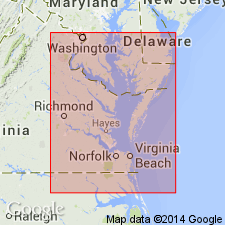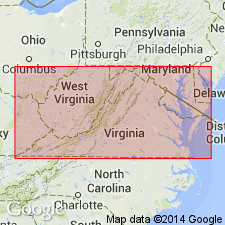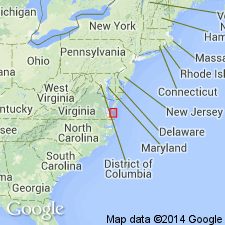
- Usage in publication:
-
- Exmore beds*
- Modifications:
-
- Informally named
- AAPG geologic province:
-
- Atlantic Coast basin
Summary:
Pg. 86 (fig. 18.1), 95, 96-97 (fig. 18.7). Exmore beds (informal). Occur in subsurface of Chesapeake Bay area, Outer Coastal Plain of Virginia. Consist of gray, clayey and silty, glauconitic sand; contains clasts which become larger and more abundant downward in section, where boulder-sized material is common. Thickness about 221 feet. [= upper part of Exmore Formation of Edwards and others, 2009.] Underlies Chickahominy Formation. Carries reworked Cretaceous to middle Eocene fauna and flora (L.E. Edwards, C.W. Poag, and R.J. Litwin, USGS, written commun., 1988). Age is considered early late Eocene (planktic foram zone P15; C.W. Poag, USGS, oral commun., 1991).
[Described from approx. depth-interval 1,200 and 1,400 ft, Exmore corehole, Accomack Co., VA; a few mi north of town of Exmore. Also recognized in Kiptopeke corehole, about 25 mi to south, in Northampton Co.]
Source: Publication.

- Usage in publication:
-
- Exmore breccia
- Modifications:
-
- Biostratigraphic dating
- AAPG geologic province:
-
- Atlantic Coast basin
Summary:
Exmore breccia (informal) is of late Eocene age based on analyses of planktonic foraminifers and calcareous nannofossils (planktonic foraminiferal biozone P15; calcareous nannofossil biozone NP19-20). Breccia clasts are as large as 2 m in length where cored; breccia matrix includes trace quantities of shocked quartz. Age of clasts identified so far include Early Cretaceous (Albian), Late Cretaceous (Cenomanian, Campanian and Maastrichtian), early Paleocene, late Paleocene, early Eocene, and middle Eocene. Also includes numerous angular pebbles of crystalline basement rock. Thickness estimated at between 1.0 and 1.2 km thick in the inner basin, averages about 250 m in the annular trough, and thins to 12 m in ejecta blanket. Youngest pre-impact lithostratigraphic unit is middle Eocene Piney Point Formation. Others, in descending order, include early Eocene Nanjemoy Formation, Paleocene Marlboro Clay and Aquia and Brightseat Formations, Late Cretaceous unnamed units, and Early Cretaceous Potomac Formation. Clasts from all these units make up the coarse fraction of the breccia. Exmore is overlain by late Eocene Chickahominy Formation (which ranges from 60 to 100 m thick over the annular trough and inner basin, thins over the ejecta blanket, and is absent beyond ejecta blanket's outer margins), followed by early and late Oligocene (informal Delmarva beds and Old Church Formation), early, middle, and late Miocene rocks (Calvert, Choptank, St. Marys, and Eastover Formations), Pliocene rocks (Yorktown Formation), and several Quaternary units. Exmore and all post-Eocene units sag structurally over the annular trough and inner basin. Chickahominy and Oligocene and early Miocene rocks are sparsely represented beyond crater's outer rim.
Source: GNU records (USGS DDS-6; Reston GNULEX).

- Usage in publication:
-
- Exmore Formation*
- Modifications:
-
- Original reference
- Dominant lithology:
-
- Breccia
- AAPG geologic province:
-
- Atlantic Coast basin
Summary:
Exmore Formation. Formal proposal. Occurs only in subsurface in and around the Chesapeake Bay impact structure. Sudivided into (ascending): (1) lower diamicton member, 10.82 to 12.69 m thick; (2) block-dominated member, 236.40 m thick; (3) upper diamicton member, 167.27 m thick; and (3) stratified member, 7.06 m thick. Total thickness 7.3 to 442. 8 m. Underlies Chickahominy Formation. Age is late Eocene.
Type section (subsurface): depth-interval 443.90 to 866.70 m (1,456.35 to 2,843.5 ft), Eyreville A core, Northampton Co., southeastern VA.
Named from town of Exmore, Northampton Co., southeastern VA, near where a section through upper part of formation was cored in 1986.
See also other papers, this vol.
Source: Publication.
For more information, please contact Nancy Stamm, Geologic Names Committee Secretary.
Asterisk (*) indicates published by U.S. Geological Survey authors.
"No current usage" (†) implies that a name has been abandoned or has fallen into disuse. Former usage and, if known, replacement name given in parentheses ( ).
Slash (/) indicates name conflicts with nomenclatural guidelines (CSN, 1933; ACSN, 1961, 1970; NACSN, 1983, 2005, 2021). May be explained within brackets ([ ]).

